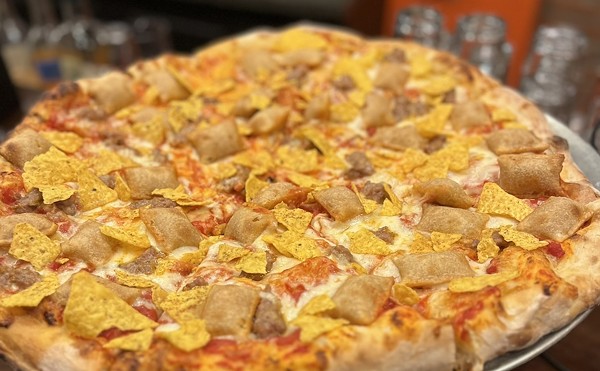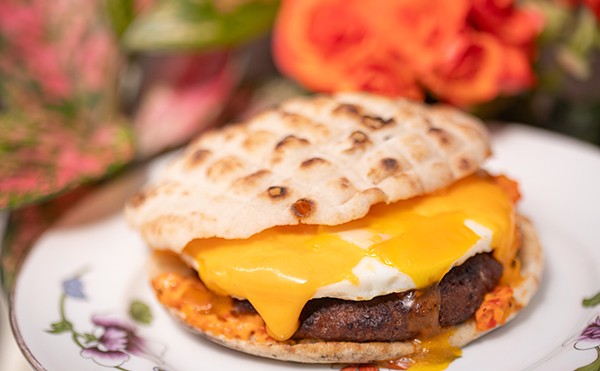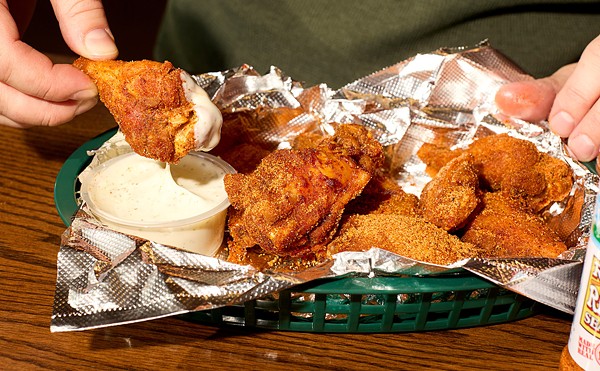The place has a couple of things going for it. First, it's owned by Pepe Kehm and Greg Perez, the chef-owners of Corky's, a restaurant with a tongue-in-cheek retro menu and inventive specials. We often drop by to munch on an iceberg-wedge salad and see what's new in the kitchen while we work the Times crossword puzzle. Surely, we thought, the partners' latest venture would be as engaging as Corky's.
Second, we liked the spaghetteria concept, as Kehm described it when we called. The restaurant is a casual place, he said, that offers value-priced, authentic meals of either spaghetti or baked spiedini. Mama Mia's spaghetti, Kehm explained, is a build-your-own pasta bowl in which the diner chooses from a list of sauces, meats and vegetables. Minestrone soup, salad and cheese-garlic bread are part of the fixed-price package, and the spiedini comes with a side of spaghetti. Customers can choose from a rotating selection of three antipasti and three desserts for an additional cost.
Tidy as it sounded, the concept did not translate well into practice. Our first clue should have been the name "Mama Mia," which is about as classy as a yard ornament. And it can't be a good sign when a restaurant has only two menu items and one of them, "spedini," is misspelled. But we think the real problem is a lack of inspiration: Kehm and Perez run Corky's as a labor of love, but they operate the spaghetteria as a cash cow. Signs of penny-pinching are everywhere, from the bobbysoxer waitresses to the thimble-sized soup cups. The tinny flatware looks as though it came from an army-surplus store. Kids at a neighborhood Catholic school created the yarn-and-construction-paper artwork -- charming but chintzy. And it's safe to say that Bob Vila hasn't dropped by wielding his saber saw in the dining room.
But that's not all. Mama Mia has an archaic cash-only policy, intended to keep MasterCard and Visa from sucking the owners dry with percent-of-sale fees. Did the phrase "cost of doing business" ever pop up in their foodservice-management classes? Customers end up taking the hit for the restaurant, ponying up $1.75 a pop to use the tacky ATM machine stationed just inside the door.
One culinary-school lecture the owners didn't sleep through was portion control. Mama Mia's meager rations make you feel as though you're eating Italian spa cuisine and paying resort prices for the privilege. A taste of three desserts or three antipasti for five bucks sounds like a bargain until you discover that a taste equals one strawberry or a lone asparagus spear. We were charged nine dollars for the antipasti Kehm proffered at the bar as we waited for a table we had been assured would be available (the spaghetteria doesn't take reservations). He doled out three dice-sized cubes of mozzarella cinched with roasted red-pepper strips and speared on toothpicks; one skinny asparagus spear moistened with balsamic vinegar and dusted with Parmigiano; and a spoonful of sautéed mushrooms. All three antipasti were respectable, but it rankles to spend that much money for five or six bites of food.
When you order an antipasto or a dessert, your waitress will fetch a communal platter from which the food is portioned out. This practice doesn't seem particularly sanitary, since the tray circulates from one server and table to the next and is not equipped with a sneeze guard. The approach also necessitates offering only cold dishes. The selections aren't listed on the menu because they're supposed to rotate like specials. However, the same choices were available during both of our visits, which were spaced two weeks apart.
The servings of spaghetti are more generous, but the pizza-parlor approach requires diners to purchase "toppings" that should be part of the sauce. Tacking on fifty cents for roasted garlic, for example, is like charging extra for the foam on a cappuccino. We ordered spaghetti with tomato sauce, garlic, capers, caramelized onions, eggplant, oven-dried tomatoes and a meatball. On another visit we selected spaghetti with cream sauce, shrimp and clams. The shrimp were plentiful, but they were as tiny as Powerpuff Girls. A jeweler's loupe and tweezers would have been required to remove their unappetizing veins. The minced clams were supplemented by two clams in-shell.
The restaurant's other entrée is spiedini, the Italian word for meat that has been spitted and then flame-grilled, baked or broiled. Sometimes the meat is stuffed and rolled before it's threaded onto skewers. Mama Mia offers the diner's choice of beef, chicken or salmon filled with a mixture of eggs, onions, cheese and bread crumbs. The spiedini is finished with a white wine lemon-butter sauce. The salmon spiedini comprises two small, well-done fillets with cavities of mushy stuffing. The chicken spiedini, on the other hand, is attractively browned, with a soft interior of seasoned bread crumbs and other ingredients. It's no chicken cacciatore, mind you, but few dishes can aspire to such heights.
This food would have been fine for an inexpensive Italian dinner. But the tab for two people, which included antipasti, dessert and a half bottle of wine, inched up to $80 plus tip on our first visit. We felt as though we'd just bought a Hyundai at $100 over invoice and driven off the lot with a $3,000 options package. We economized on our next visit, sharing a plate of antipasti and skipping dessert, which brought the sticker price down to $53 plus tip.
Kehm, expressing admiration for the Pasta House empire, confided that he and Perez plan to open a chain of spaghetterias in St. Louis. They have no shortage of chutzpah, given that the concept is untested in this market and has barely finished its first month of operation. The place will be easy to replicate, he reasons, and has a much higher profit margin than the more upscale Corky's. But perhaps these two talented chef-restaurateurs should rub the dollar signs out of their eyes and remember the axiom, "Do what you love and the money will follow."





